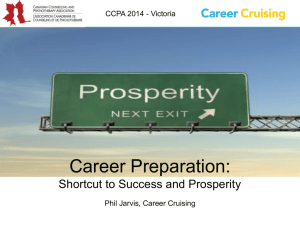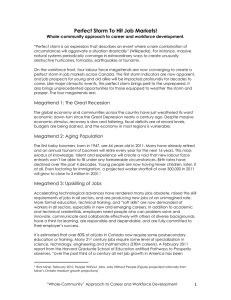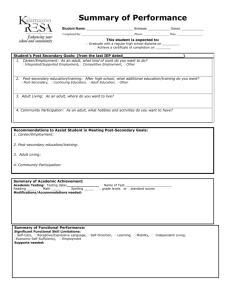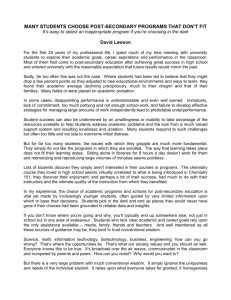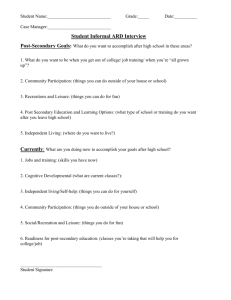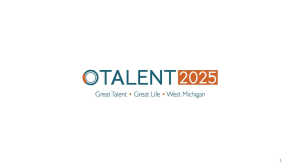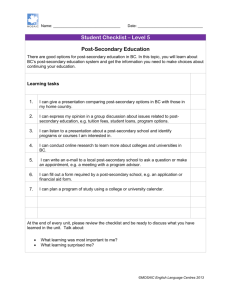(Wake Up Canada!) The perfect storm
advertisement
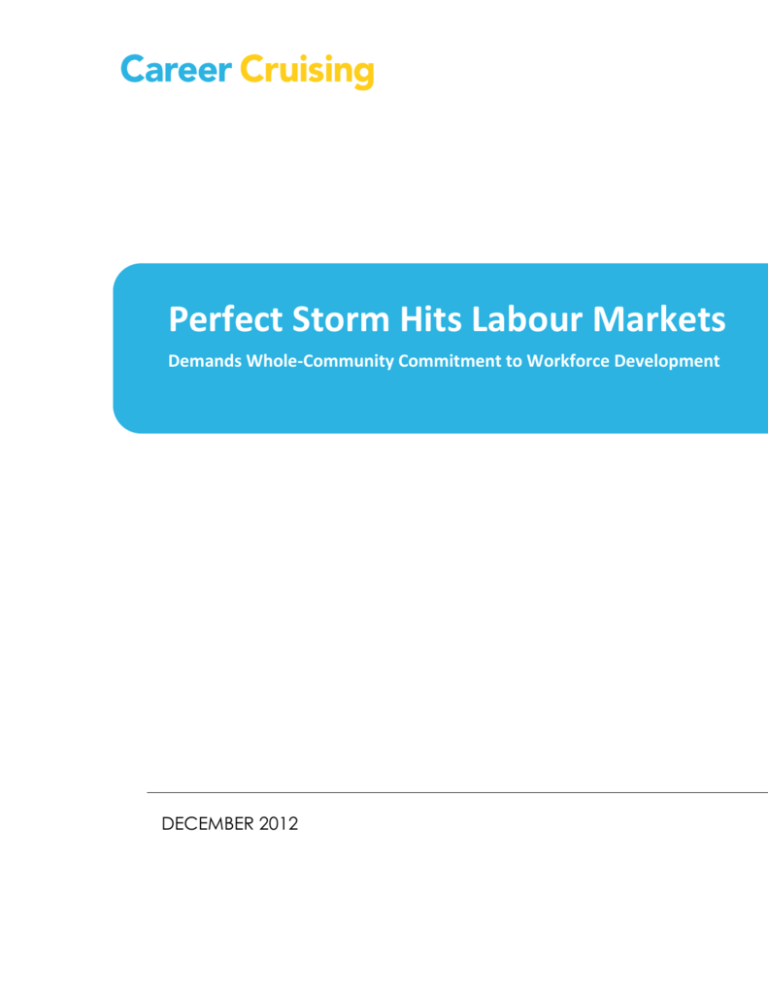
Perfect Storm Hits Labour Markets Demands Whole-Community Commitment to Workforce Development DECEMBER 2012 INTRODUCTION Massive natural systems periodically converge in extraordinary ways to create unusually destructive hurricanes, tornados, earthquakes or tsunamis. On the workforce front, four labour force megatrends are converging to create a perfect storm in job markets across Canada. The first storm indicators are now apparent. Job prospects for young and old alike will be impacted profoundly for decades to come. Like major climactic events, this perfect storm brings peril to the unprepared. It also brings opportunity for those equipped to weather the storm and prosper. The four megatrends are: MEGATREND 1: THE GREAT RECESSION The global economy and communities across the country are weathering the worst economic downturn since the Great Depression nearly a century ago. All levels of government are in deep and record debt, trying to find a balance between budget reductions, program and service cutbacks, and economic stimulus. Recovery is slow and faltering, companies are reluctant to invest in new people and productive capacity, and individuals, families, and communities in all regions are vulnerable. MEGATREND 2: AGING POPULATION The first baby boomers turned 65 in 2012. Many have already retired and an annual tsunami of boomers will retire over the next 20 years. This mass exodus of knowledge, talent and experience will create a void that new labour force entrants won’t be able to fill under any foreseeable circumstances. Birth rates have declined over the past 4 decades. Young adults are having fewer children, later. Even factoring for immigration, Canada’s projected worker shortfall of over 300,000 in 2012 will grow to 3 million or more in 2031.1 MEGATREND 3: UPSKILLING OF JOBS Accelerating technological advances have rendered many jobs obsolete, enabled robots to replace people in others, raised the skill requirements of jobs in all sectors, and are producing new jobs at an unimagined rate. More formal education, technical training, and “soft skills” are now demanded of workers in all sectors, especially in new and emerging career fields fuelled by technological innovation. Employers need people who can problem-solve and innovate, communicate and collaborate effectively with others of diverse ethnicities and backgrounds, have a thirst for learning, are responsible and dependable, and are fully committed to their employer’s success. It is estimated that 77% of all jobs by 2031 will require a postsecondary 1 Rick Miner, Ph.D., 2012, Jobs of the Future: Options and Opportunities PERFECT STORM HITS LABOUR MARKETS | Page 2 certificate, diploma, or degree.2 A 2011 report from the Harvard Graduate School of Education entitled Pathways to Prosperity observes, “over the past third of a century all net job growth in America has been generated by positions that require at least some post-secondary education.” Many 21st century jobs require some level of specialization in science, technology, engineering and mathematics (STEM careers). Despite high unemployment and underemployment, particularly among youth, employers across the spectrum of industry sectors are reporting serious challenges finding the talent they need to fill “mission-critical” positions. We are entering a prolonged era during which increasing numbers of people without jobs will co-exist with an even larger number of jobs without people.3 This should spell a “buyers market” for job seekers. Unfortunately, most of the jobs without people don’t want the people without jobs. Employers need people with 21st century skills most unemployed people don’t possess. On the upside, this may be the best period in history to be imagining and preparing for a career, or a career transition. In our increasingly “flat world,” one can now work for any organization in the world, and vice versa. More career options are available than ever, with new technology creating new types of jobs every day. Young people and adults who know themselves and understand their assets, are aware of emerging career opportunities, have a sense of direction and purpose, and are prepared to do what it takes to acquire the education, skills and attitudes employers need, will have employers competing for their talents throughout their entire career. The economic consequences of having too many citizens unemployed or underemployed are staggering. Lost productivity and reduced competitiveness impact employers. Lost tax revenues, social assistance, corrections, and stress-induced health costs alone run into $billions annually for all levels of government. The human consequences are higher. With the coming perfect storm, helping as many citizens as possible connect with fulfilling, family-sustaining 21st century careers has become an economic imperative. They most effective way for governments to unburden themselves of debt, and companies to increase productivity and grow, is by getting the best possible people in the right jobs, fully engaged in creating economic prosperity for their companies and their communities. MEGATREND 4: UNPREPARED WORKFORCE The primary source of new workforce talent is the education and training system. Canada has a higher post-secondary participation rate than most countries. Nonetheless, we have a long way to go to equip students for success in 21st century labour markets. Canada’s national high school 2 3 Rick Miner, Ph.D., 2012, Jobs of the Future: Options and Opportunities Ibid PERFECT STORM HITS LABOUR MARKETS | Page 3 graduation rate in 2012 was 79%.4 Even so, job prospects for the 1 out 5 students who drop out of high school are bleak. About 60%5 of Canada’s high school graduates immediately register for post-secondary programs (vocational, technical, trade, college, university), bringing a 79% high school graduation rate down to a 47% post-secondary admissions rate. Of these, 25% drop out before the end of their first year, and a similar percentage change programs6. 60% of those who register in post-secondary programs will eventually graduate, the majority now taking longer than the prescribed program period.7 Bottom line: Of 100 students in the educational pipeline in grade 9 fewer than 30 will graduate without interruption with a post-secondary certificate, diploma or degree. Yet, most 21st century jobs require at least some post-secondary education. Thus, far too many young people begin their careers carrying onerous student loan debt, without the knowledge, skills and credentials employers need, and without a clear idea of their career goals. At best, their early career years will be a rough ride, and companies starving for talent will not find what they need. In explaining why the United States now has the highest post-secondary dropout rate in the industrialized world, the Harvard Graduate School of Education concludes, “Too many students can’t see a clear connection between their program of study and labor market opportunities.”8 This holds true in Canada, not just in post-secondary programs. Far too many students, at all educational levels and settings, fail to see personal relevance in what they are expected to learn, and can’t visualize real jobs and a viable career trajectory at the end of the educational pipeline. With the best of intentions, educators tend to see education itself as the objective. With enough education the future will take care of itself. It did for them. Yet, they are in the only profession that enjoys 16 or more years of job shadowing and work experience before choosing to remain in a familiar setting lifelong. Students, parents, and employers see education as preparation for success in life and career. Students who cannot picture themselves in a classroom lifelong become increasingly anxious about what they will do when they graduate. Supportive teachers and parents with high expectations help them stay engaged. However, lacking an appealing vision of their future prospects, many students see no point in fully engaging in school, thus underachieve. That may have been tolerable in the industrial era, but today’s students need academic success and a broad spectrum of employability skills more than any cohort before them. Education Indicators: An International Perspective, 2011, Statistics Canada and Council of Ministers of Education of Canada 5 King, 2009, Who Doesn’t Go to Post-Secondary Education? 6 Miner, 2010, People Without Jobs, Jobs Without People 7 Parkin, Baldwin, 2009, Research Note #8, Persistence in Post-Secondary Education in Canada: Millenium Scholarships 8 Pathways to Prosperity, February 2011, Harvard Graduate School of Education 4 PERFECT STORM HITS LABOUR MARKETS | Page 4 THE ccENGAGE WHOLE-COMMUNITY SOLUTION Gallup’s unprecedented global polling9 since 2005 shows that the number one social value around the world, the new global dream, is to have a good job. Communities that pull together to help their citizens get good jobs, and employers attract good employees, will prosper in spite of the perfect storm. Those that fail to provide good jobs will lose citizens to communities that do. It is in every citizen’s best interests to help family members and fellow citizens achieve career success. A good career provides the foundation for independence, building a happy and secure family, buying a home and car, purchasing goods and services from local businesses, a healthy lifestyle, and engaged citizenship. Given the importance the entire world now places on a good job, and given employers’ increasing challenge in securing the talent they need to prosper in an era of global competition, it is remarkable how superficially and haphazardly society approaches career and workforce development. Students can complete 16 or more years of studies without receiving any significant guidance about their future career prospects. The majority of adults “end up” in their jobs more through chance, happenstance, and serendipity than informed and intentional career planning. Employers accuse educators of failing to produce graduates with the skills, attitudes and character they need. Yet, they are reluctant to step up and contribute, even to training and developing their current employees. Gallup Chairman Jim Clifton estimates that 28% of workers are “actively engaged” in their work, about the same number are “actively disengaged” (sabotaging their employers), and the balance are doing just what they have to do to keep getting paid. Our cavalier approach to career and workforce development now seriously jeopardizes future prosperity for all Canadians. Career Cruising’s primary mission is to engage and inspire people to explore themselves and their career options and navigate educational and training pathways to a series of good jobs with good employers on a career trajectory leading to happiness, fulfillment, and prosperity. Career Cruising has developed the ccEngage suite of cloud-based tools that enable a wholecommunity approach to career, workforce and economic development, beginning in kindergarten and continuing lifelong. In a community committed to helping its citizens succeed, ccEngage can be used in a harmonized way by all students, educators, parents, unemployed and underemployed adults, employers, community and government agencies. 9 Gallup Chairman Jim Clifton, 2011, The Coming Jobs War PERFECT STORM HITS LABOUR MARKETS | Page 5 THE ccENGAGE SUITE ccSPARK! (GRADES K TO 5) Launched in the Fall of 2012, ccSpark! is an engaging and fun Digital Learning Game for elementary students in grades K to 5 that seeks to teach and inspire students about the importance of social skills, life-planning and careers. At the heart of ccSpark! is Sparkdale, a role-playing-game that adapts to the child’s curricular needs in an age-appropriate manner. In addition to the online game Sparkdale, ccSpark! provides online activities and students build a personal profile through SparkCentral. Offline classroom activities in the Teachers Guide and a “For Parents” section further support career development learning appropriate for the elementary age group. ccSpark! is a flexible program built to accommodate in-class discussion support, that is rich in on- and off-line career development curriculum. PERFECT STORM HITS LABOUR MARKETS | Page 6 ccTHEREALGAME (GRADE 3 to High School) There are two elementary programs, one middle school, and one high school program in The Real Game Series. Although each program is unique and different, each introduces students to the “real world” of work and career by having them role-play adult characters. They create neighborhoods, find jobs, balance work, leisure, and budgets, create lifestyles, and collaborate as engaged citizens in the virtual communities they create. Once they have “seen the future” they realize success in school is vital to achieving their dreams. Respect for adults, like their parents and teachers increases, and students become more engaged in their education and career planning. These programs are the product of unprecedented collaboration between over 30 Departments of Education across the United States and Canada, funded by the National Occupational Information Coordinating Committee (Perkins) in the U.S. and the Government of Canada (HRSDC). One or more ccTheRealGame programs have since been adopted by The United Kingdom, France, Australia, New Zealand, The Netherlands, Germany, Ireland, Hungary, and Greece. ccSPRINGBOARD (GRADES 6 TO ADULT) Helping people of all ages achieve their full potential in school, career and life, ccSpringboard is the heart of the ccEngage solution. It comes complete with an interactive ePortfolio, Matchmaker assessment tool, multimedia occupational profiles, detailed career information, comprehensive information on post-secondary programs and institutions, work search information, a resume-builder, and much more. A Parent Portal allows parents to help their children explore educational and career plans and support them in developing and maintaining a rich, living ePortfolio. ccSpringboard is used in more than 10,000 schools, libraries and employment one-stops across the United States. ccPATHFINDER (GRADES 8 TO 12) ccPathfinder encourages high school students to think about the impact their studies have on achieving their future goals. With a few clicks, it helps them set up a complete 4-year program of courses in perfect alignment with their school’s graduation requirements and their own informed career dreams and aspirations. Through the Parent Protal, parents can become directly involved in helping their children keep their options open and make course selections perfectly in tune with their career and life goals. Over 1 million Canadian and American students submitted their course requests in 2012 through ccPathfinder. ccINSPIRE (GRADES 8 AND BEYOND) ccInspire helps students achieve career goals, companies nourish the local talent pool, and administrators develop a stronger workforce to benefit entire communities and boost the regional economy. It enables students to test their career goals by asking, “If I graduate from the education or training programs I’m now targeting, who might PERFECT STORM HITS LABOUR MARKETS | Page 7 employ me, and how can I meet them now?” It allows employers to create a pipeline of future talent by asking, “What students are now in high school, or post-secondary programs within a 50 mile radius of our operation dreaming of working in occupations we are going to need, and how can we meet them now?” The relationships that ensue could include work experience, jobshadowing, co-op placements, mentorships, part-time or summer employment, and allow both the student and employer to “test the fit.” When students know a specific employer is interested in them, their motivation to become fully engaged in learning increases. When employers know thay have excellent local prospects in the pipeline they are more inclined to invest in growing their operations. Career Cruising (careercruising.com) welcomes opportunities to partner with education, business and community leaders wishing to make a whole-community commitment to workforce and economic development. For more information contact us at http://public.careercruising.com/ca/en/contact/get-in-touch PERFECT STORM HITS LABOUR MARKETS | Page 8
